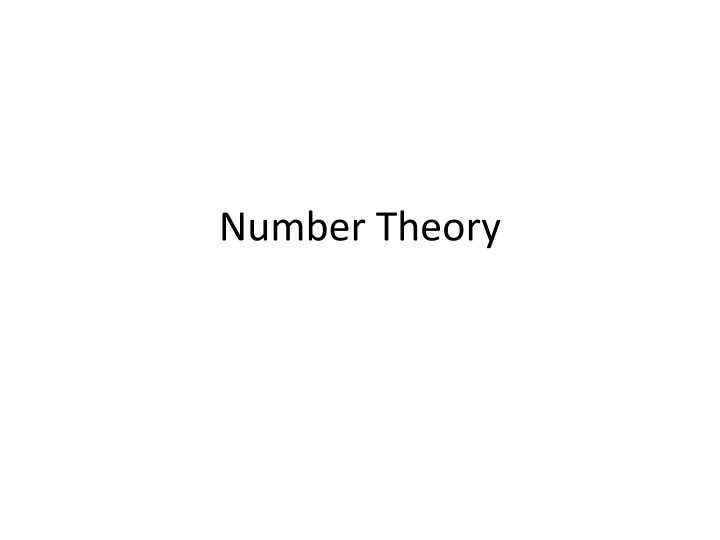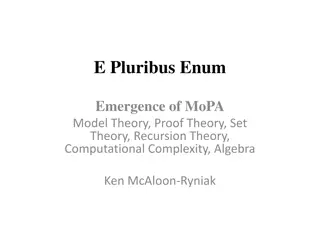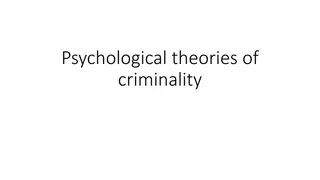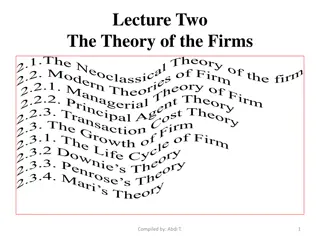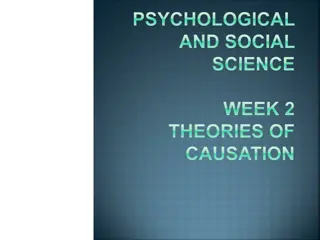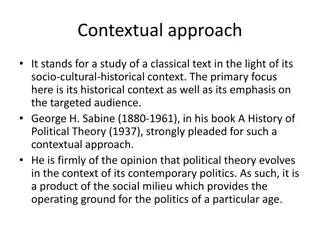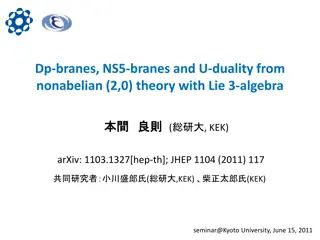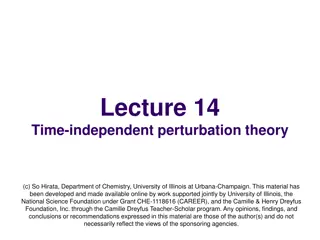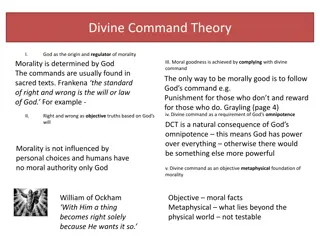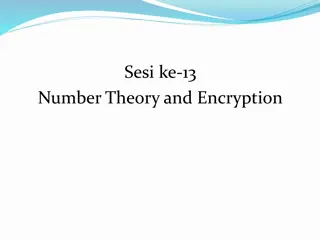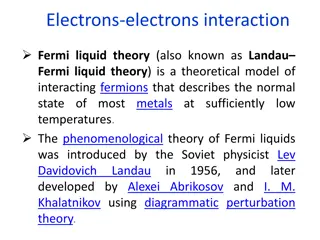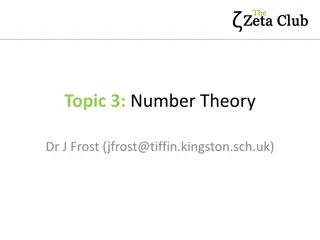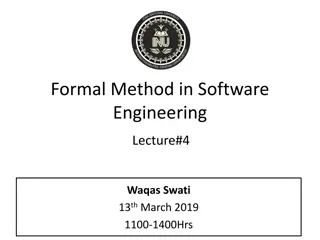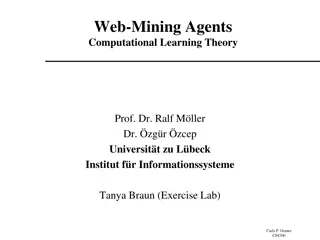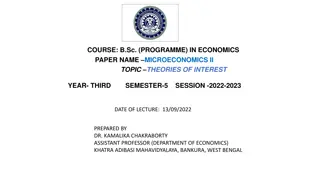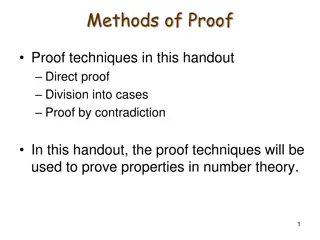Number Theory Fundamentals
Explore the fascinating world of number theory covering ancient problems like factoring and primality testing. Learn about prime numbers, prime factorization, primality testing, and basic arithmetic operations. Discover modular arithmetic and its applications in dealing with a restricted range of numbers efficiently. Dive into the essence of elementary number theory and its significance in understanding the building blocks of integers.
Download Presentation

Please find below an Image/Link to download the presentation.
The content on the website is provided AS IS for your information and personal use only. It may not be sold, licensed, or shared on other websites without obtaining consent from the author.If you encounter any issues during the download, it is possible that the publisher has removed the file from their server.
You are allowed to download the files provided on this website for personal or commercial use, subject to the condition that they are used lawfully. All files are the property of their respective owners.
The content on the website is provided AS IS for your information and personal use only. It may not be sold, licensed, or shared on other websites without obtaining consent from the author.
E N D
Presentation Transcript
Two ancient problems Factoring: Given a number N , express it as a product of its prime factors. Primality: Given a number N, determine whether it is a prime. Factoring is hard. Despite centuries of efforts the fastest methods for factoring a number N take time exponential in number of bits of N. On the other hand, we can efficiently test whether N is prime!
Elementary Number Theory Prime Numbers building block of integers every positive integer can be written uniquely as a product of prime numbers difficult to write large integers as a product of primes.
Elementary Number Theory Prime Factorization Use N = {1, 2, 3, .} Use Z = { ., -2, -1, 0, 1, 2, } Defn: An integer n is prime if the only divisors are 1 and n. We call a number composite if it is not a prime.
Finding Primes Use repeated division start from the smallest possible divisor and then try all divisors up to the square root of the number once we notice that the number is not even, we try the odd numbers as the candidate divisors. termination condition : i*i > sqrt(n).
Basic arithmetic Addition The sum of any three single-digit numbers is at most two digit long. The cost of each addition of two integers m and n is O(log m +log n).
Basic arithmetic Multiplication and Division multiplying two integers m and n cost O(log m.log n). Can do better with divide-and-conquer.
Modular arithmetic Repeated addition and multiplication can get the result cumbersomely large. Modular arithmetic is a system for dealing with restricted range of numbers.
Modular Arithmetic We do arithmetic with the set (rings) of integers {0,1,2, , N-1} using addition and multiplication where the sum and product of two elements of that set is again in the set. We define x modulo N to be the remainder when x is divided by N; that is, if x=qN + r with 0 r < N, x modulo N is equal to r. We write this as x = r mod (N). x = y (mod N) implies N divides (x-y). 253 mod 60 = 13 253 13 (mod 60) ; 250 13 is divisible by 60. 15 21 mod 4 = 315 mod 4 = 3; 15 21 mod 4 (15 mod 4) (21 mod 4) = 3 1 = 3
Addition and Subtraction ((x mod n) + (y mod n)) mod n (12 mod 100) (53 mod 100) 41 mod 100 = 59 mod 100 ll
Addition and Subtraction ((x mod n) + (y mod n)) mod n The last mod n due to the fact that (x mod n)+(y mod n)) could greater than n. (12 mod 100) (53 mod 100) 41 mod 100 = 59 mod 100 ll
Exponentiation In cryptosystem, it is necessary to compute xy mod N for values of x, y, and N that are several hundred bits long. Like to evaluate 2 (19*(524288)) mod (N).
Exponentiation xy mod n = (x mod n)(y mod n) mod n xy mod n = (x mod n)y mod n
Modular exponentiation number of bits to represent xy = O(ylog x) number of bits to represent xy mod N is O(log N).
Greatest Common Divisor gcd is the largest divisor shared by a given pair of integers. If b divides a (i.e. b|a), gcd(a,b) = b Note b|a implies a= bk. gcd(bk,b) = b. If a = bt + r for integers t and r, gcd(a,b) = gcd(b,r). Lemma: for any integers a and b, we can show that gcd(a,b)= gcd(b,a) = gcd(+/- a, +/- b) =gcd(a ,a-b) = gcd(a, a+b)
Euclids algorithm (discovered 2000 years ago) gcd(a, b) // assume that a > b If b=0 then return a. Compute r = a mod b return gcd(b, r) This takes logarithmic time. after every two iterations, the largest number gets reduced by a half at least.
Euclids algorithm (discovered 2000 years ago) gcd(a, b) // assume that a > b If b=0 then return a. Compute r = a mod b return gcd(b, r) This takes logarithmic time. after every two iterations, the largest number gets reduced by a half at least.
gcd(252,198) 252 = 1 198 + 54 198 = 3 54 + 36 54 = 1 36 + 18 36 = 2 18 + 0
Important Property Given any two integers a and b, there exist integers x and y, such that ax + by = gcd(a,b). a = floor(a/b).b + r We know that gcd(a,b) = gcd(b,r). Assume that we know integers x and y such that b.x + r. y = gcd(b,r) = gcd(a,b) Substituting r we get b.x + (a b . floor(a/b)).y = gcd(a,b) Rearranging we get ay + b.y = gcd(a,b). (x and y are integers) here x = x b.floor(a/b).y gcd(a,b) = xa +by where a and b are integers
A simple extension of Euclids algorithm
gcd(252,198) 252 = 1 198 + 54 198 = 3 54 + 36 54 = 1 36 + 18 36 = 2 18 + 0 18 = 54 1 36 18 = 54 1 (198 3 54) = 4 54 1 198 18 = 4 (252 1 198) 1 198 = 4 252 5 198 Therefore, gcd(252,198) = 4 252 5 198
Important Property if d divides a and b, d divides ax + by for any d. Therefore, ax + by = d. t. When d = gcd(a,b), t=1.
Modular division In real arithmetic, every number a ( 0) has an inverse, 1/a. Multiplying by 1/a is the same as dividing by a. In modular arithmetic we can make a similar definition: x is a multiplicative inverse of a modulo N iff ax = 1 (mod N). Theorem: The inverse of a modulo b exists and is unique iff a is relatively prime to m, i.e. gcd(a,b) = 1. gcd(a,b) = 1 implies ax + by = 1 for some integer x and y ax = 1 by implies ax 1 (mod b).
Modular division In real arithmetic, every number a ( 0) has an inverse, 1/a. Multiplying by 1/a is the same as dividing by a. In modular arithmetic we can make a similar definition: x is a multiplicative inverse of a modulo N if ax = 1 (mod N). There could be at most one such x modulo N. The inverse x is unique modulo b, since if x is also an inverse, then ax ax 1 implies xax xax x x .
Modular division However, inverse doesn t always exist. There doesn t exist any x such that 2x = 1 (mod 6). The necessary and sufficient condition for an x to exist in ax = 1 (mod b) is that gcd(a,b) = 1, i.e. a and b are relatively prime.
Congruences Congruences are an alternate notation for representing modular arithmetic. We say that a b(mod m) if m|(a b). By definition, if a mod m is b, then a b(mod m) a and b are congruent.
Congruences It gets us thinking about the set of integers with a same given remainder, and gives us equations for representing them. What integers x satisfy the congruence x 3(mod 9)? The set of solutions is all integers of the form 9y + 3, where y is any integer.
Congruences What about 2x 3(mod 9) and 2x 3(mod 4)? Trial and error should convince you that exactly the integers of the form 9y + 6 satisfy the first example, while the second has no solutions at all. We need to find a way to solve them.
Operations on Congruences Congruences support addition, subtraction, and multiplica- tion, as well as a limited form of division provided they share the same modulus:
Operations on Congruences Division concept is difficult. We can simplify a congruence ad bd( mod dn) to a b(mod n), so we can divide all three terms by a mutually common factor if one exists. Thus 170 30(mod 140) implies that 17 3(mod 14). However, the congruence a b(mod n) must be false (i.e., has no solution) if gcd(a, n) does not divide b.
Solving Congruences A linear congruence is an equation of the form ax b(mod n). Solving this equation means identifying which values of x satisfy it. Not all such equations have solutions. ax 1(mod n) has a solution if and only if the modulus and the multiplier are relatively prime, i.e., gcd(a,n) = 1. Euclid s algorithm to find this inverse through the solution to a x +n y = gcd(a,n) = 1. x is the solution
Solve the equation 247x + 91y = 39 We need to find an x and y (integers) We find that gcd(247,91) = 13. Since 13 divides 39, we have a solution. We can write 3 247 8 91 = 13 or 3 19 8 7 = 1 or 3 19 19 7 t + 19 7 t 8 7 = 1 or 19 ( 3 7t) + 7 ( 19t -8) = 1 for any integer t Therefore, x = 3 -7t and y = 19t 8. (ans)
Primality Testing Is your social insurance number prime? Modern cryptography is about the following important idea: factoring is hard and primality testing is easy. We cannot factor a large number (500 bits), we can test its primality information.
Fermats Little Theorem If p is prime, then for every 1 a < p, a p-1 = 1 (mod p). A proof can be found in the book Algorithm by Dasgupta, Papadimitriou and Vazirani.
Start by listing the first p-1 positive multiples of p. a, 2a, 3a, ., (p-1)a It can be shown that {a mod p, 2a mod p, , (p-1)a mod p} = {1, 2, ,(p-1)} for prime p and 1 a < p. Therefore a.2a.3a. . (p-1)a 1.2.3 ..(p-1) mod (p-1) or better ap-1(p-1)! (p-1)! mod (p-1) or ap-1 1 mod (p-1)
An algorithm for testing primality Fermat s Theorem is not an if and only if condition. The theorem says that if N is a prime number, it will pass the test. If it doesn t pass the test, it is not a prime (contrapositive argument) It is possible that, for a given N, it can pass the test but it is not a prime.
Carmichael number The smallest such number is 561 = 3 . 11 . 17. It passes Fermat s test. Clearly it is not a prime. There are infinitely such Carmichael numbers. if we ignore Carmichael numbers, it can be asserted that Pr(The algorith returns yes when N is prime) =1 Pr(the algorithm returns yes when N is not a prime) .
An algorithm for testing primality, with low error probability Pr(the algorithm returns YES when N is not a prime) 1/2k.
Generating random primes For cryptographic applications, we need to generate large primes (like 500-bit number). Prime numbers are quite abundant. There are approximately (N/logeN) primes with values no greater than N. The probability of a randomly generated n-bit number to be prime is (1/(loge2n) (approximately, 1.44/n).
Generating a random n-bit prime Pick a random n-bit number N. Run a primality test on N. If it passes the test, output N; else repeat the process. Acceptance has probability 1/n. The expected number of iterations before the program halts is n.
RSA Encryption Algorithm A classic application of modular arithmetic on large integers. The message is encrypted by coding it as an integer m, raising it to power k, where k is the so-called public-key or encryption key. Taking the results mod n. Since m, n, and k are all huge integers, computing mk mod n efficiently requires tools we are seeing here.
